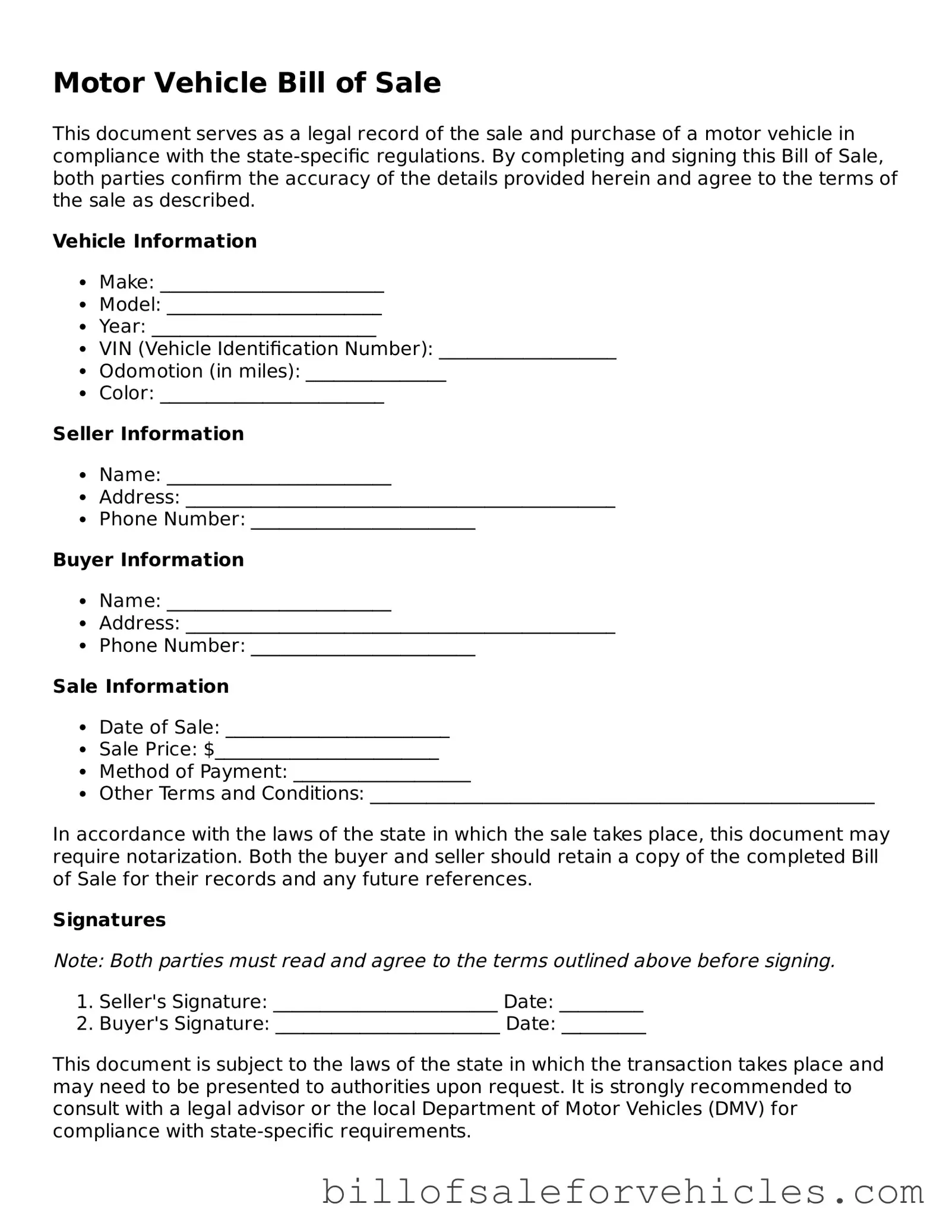What is a Motor Vehicle Bill of Sale form?
A Motor Vehicle Bill of Sale form is a legal document that records the sale or transfer of a vehicle from one party to another. It serves as proof of purchase and includes important information such as the date of sale, purchase price, and specifics about the vehicle, like its make, model, year, and Vehicle Identification Number (VIN). This form is crucial for establishing the legal ownership of the vehicle.
Is a Motor Vehicle Bill of Sale form required in all states?
No, not all states require a Motor Vehicle Bill of Sale form for a vehicle transaction. However, it's highly recommended to complete one even if it's not mandated by your state, as it provides a written record of the sale. Each state has its own regulations regarding vehicle transfers, so it's important to check with your local department of motor vehicles (DMV) or equivalent agency for specific requirements.
What information is typically included in a Motor Vehicle Bill of Sale form?
Typically, a Motor Vehicle Bill of Sale form will include the names and addresses of both the seller and the buyer, the sale date, the sale amount, and detailed information about the vehicle being sold. This includes the make, model, year, color, VIN, and odometer reading at the time of sale. It may also include terms of the sale and any warranties or certifications regarding the vehicle's condition.
Why is it important to have a Motor Vehicle Bill of Sale?
Having a Motor Vehicle Bill of Sale is important because it legally documents the transfer of ownership and specifics of the transaction. It can serve as a valuable record for tax purposes, resolves potential disputes over ownership, and may be required by your state's DMV for registration and titling of the vehicle. It also provides peace of mind for both the buyer and seller.
Can a Bill of Sale be hand-written?
Yes, a Bill of Sale can be hand-written as long as it contains all the required information. However, to ensure clarity and avoid potential disputes, using a typed or pre-printed form is often preferred. Regardless of the format, both parties should keep a copy.
Does the Motor Vehicle Bill of Sale form need to be notarized?
Whether a Motor Vehicle Bill of Sale form needs to be notarized depends on the state's requirements. Some states require notarization to validate the document's authenticity, while others do not. It's important to check with your local DMV or similar entity to understand the specific requirements in your state.
What happens after completing a Motor Vehicle Bill of Sale form?
After completing a Motor Vehicle Bill of Sale form, both the buyer and the seller should keep a copy for their records. The buyer will likely need to present this document to the DMV as part of the registration and titling process. It's also a good idea to update insurance providers about the change in vehicle ownership.
Can a Motor Vehicle Bill of Sale form be used for vehicles from any state?
While a Motor Vehicle Bill of Sale form generally contains basic information relevant to most vehicle transactions, specific requirements can vary by state. It's advisable to use a form that complies with the laws of the state where the vehicle transaction occurs or to consult with a legal professional to ensure the form meets all local requirements.
What should I do if I lose my Motor Vehicle Bill of Sale?
If you lose your Motor Vehicle Bill of Sale, it's recommended to contact the other party involved in the transaction to request a copy. If that's not possible, or if both parties have lost the document, you may consult with a legal professional about the steps to take, such as drafting a replacement document that both parties can sign again. It's also worth checking with the local DMV for advice, as they may have on record a copy or the information that was submitted for registration and titling purposes.
